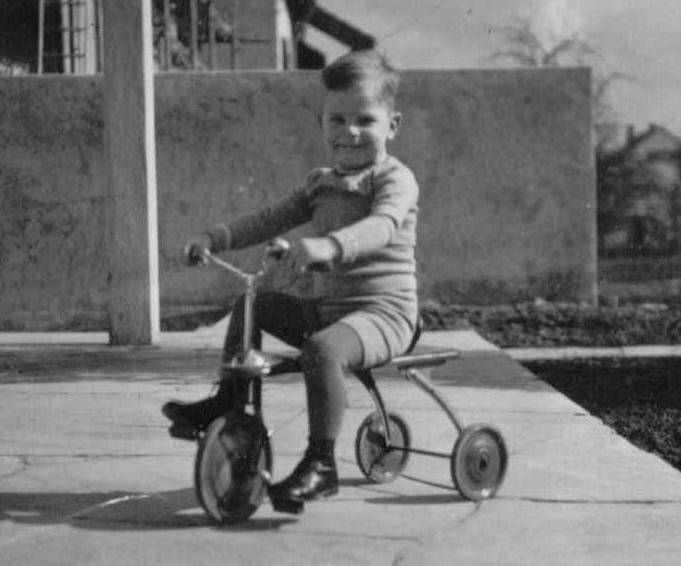
German Toys: Vehicles

Figure 1.-- This boy lived in Stutgart during 1937. Itvappeas to be a new housing development. The boy looks about 3 years old. He is riding a tricycle. Notice the stearing. It had rubber tires. This would have been a very expensive item beyond the range of many families. The boy is wearing a knitted suit with short trousers and long brown stockings.
|
|
We see German boys enjoying a range of vehicles. They are not really toys, but childhood vehicles. Younger boys played with scooters and tricycles. Scooters seem paticularly popular. We see some boys with a tricycle like toy, but without pedal drive. Many scooters were made in wood rather than metal. We see many more scooters than other types of children's vehicles. This is probavly an economic matter. A scooter had no pedals and chain drive. Thus it was a much less expensive item than a bicycle. We do not note the many different types of pedal cars that were popular in America. Older boys enjoyed bicycles. We see German boys taking group cycling trips. This seems particularly popular as a Hitler Youth activity. We see whole units taking bike trips. good example is depicted in a photographic album put together by Rudolf Hanig, a seemingly orinary HJ boy.
We do not have alot of information on this, but we believe that most of the boys involved did not own their own bikes.
We note quite a few photographs of German boys with bikes. Germany did not play a major role in the development of the bicycle, but there was some work in Germany. Baron Karl Drais von Sauerbronn, who invented the "draisine" in 1817, 2 in-line wheels connected by a wooden frame. The rider sat astride and pushed it along with his feet, while steering the front wheel. Bikes became very popular in Germany and several mnufacturers produced them. We note a few boys had bikes in the late-19th century. A good example is an unidentified German boy in 1888 with a penny-farthing bicycle. Bikes in the 19th century were not all that safe. Manufacturers by the 20th century were producing bikes that boys could safely operate, although somewht expensive for many families. Many workers used bikes for transport to work. Cars were beyond the price that workers could afford. After World War I it became more common for boys to have bikes, at least middle-class boys. We note a German father and son about 1905-10. We note Hitler Youth boys taking biking expeditions in the 1930s. We note some girls with bikes, but most of the images we have founds are boys riding them. German boys commonly wore short pants wuth riding bikes. Lederhosen were a popular choice.
Rudolf Hanig, a seemingly orinary HJ boy.
We do not have a lot of information on this, but we believe that most of the boys involved did not own their own bikes.>
The Irish mails were a child';s vehicle rhat appeared in the early 20th century. It was propelled by hand rather than leg saction. They were prominently featured in American catalogs, but not very common in the photographic record. They were even rarer in Germany, but we have found a few images. We believe that the relative prominance in the photographic record is a good indicator of just how popular they were. We do not know what Irish Mails were called in Germam.
Pedal Cars
We do not note the many different types of pedal cars that were popular in America.
We have little information about scooters at this time. We have not noted them before World war I (1914-18), but have no detailed informstion at this time. They were mostly for younger children at the age that they were just beginning to ride bikes, perhaps children that did not have bikes yet. They were also cheaper than bikes. We begin noticing them in the 1920s. I recall them as a boy in America during the 1940s. Scooters appear to have past out of favor in the early 1950s. We do not recall seeing them in the 1960s. We do notice sleeker models appearing about 2000. We do not know what countries they were popular in. We see scooters advertized in French catalogs. Here we see them in Germany beginning in the 1920s (figure 1). We note quite a few German boys with scooters. We see another German boy with a scooter, probably in the 1950s. Interesting there was a revival of scooters in the late 1990s, but this was more of a scooter for teenagers and young adults. We are not sure what the foreign language terms were.
Younger German boys also enjoyed playing with tricycles. The three wheels provided the increased stability that younger children needed for these play vehicles. We see quite a few boys with tricycles. Not as many as in America, but more than in other European countries--except perhaps Britain. Most example we have seen are after World War I. The first ones we see seem very basic. We generally see boys rather than girls riding them. We notice sevefal different styles and features. There were also different types of trikes. had pedal drives. We also see some boys with a tricycle like toy, but without pedal drive. With trikes we mostly see the children as might be expected playing around the house.
HBC

Navigate the Boys' Historical Clothing Web Site:
[Return to Main German child vehicle page]
[Return to Main German toy page]
[Introduction]
[Activities]
[Biographies]
[Chronology]
[Clothing styles]
[Countries]
[Bibliographies]
[Contributions]
[FAQs]
[Glossaries]
[Images]
[Links]
[Registration]
[Tools]
[
Boys' Clothing Home]
Created: 3:28 AM 2/12/2009
Last updated: 3:19 AM 10/22/2010



